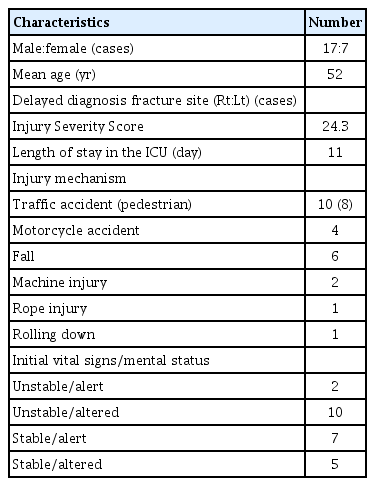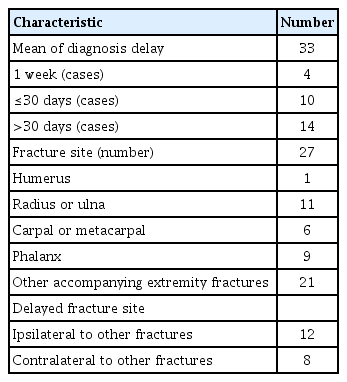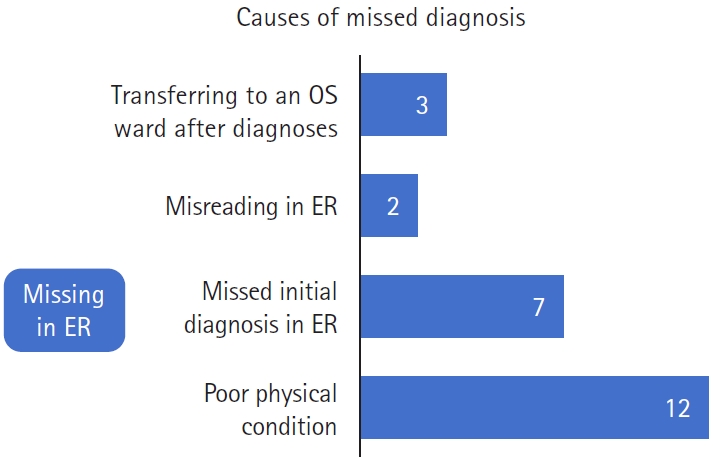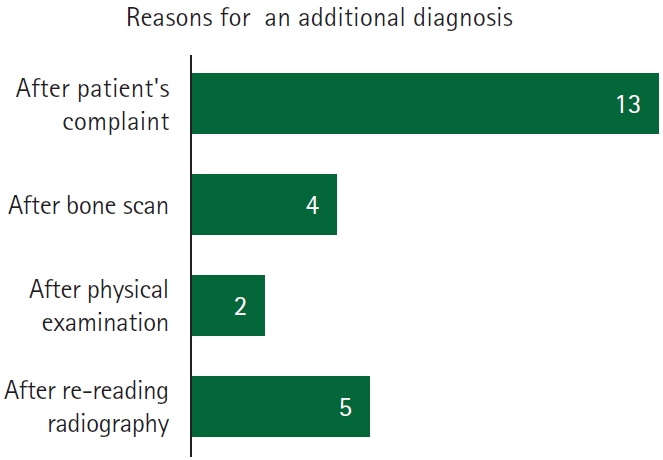Neglected upper-extremity fractures at a severe trauma center in the Republic of Korea
Article information
Abstract
Purpose
Missed injuries and delayed diagnoses are likely when diagnosing patients with severe trauma. This research aimed to investigate the incidence of missed fractures in the upper extremities by retrospectively analyzing factors leading to an overlooked diagnosis.
Methods
We retrospectively investigated patients hospitalized with newly diagnosed upper-extremity fractures after an initial diagnosis at Severe Trauma Center of Pusan National University Hospital. We analyzed the accompanying injuries, Injury Severity Score (ISS), reasons for a missed diagnosis, and treatment results.
Results
Twenty-four patients and 27 cases were identified. The incidence of fracture was 0.4%, and the average diagnostic period was 33 days. The mean ISS was 24.3. Among the 27 cases of neglected fractures there were 1 intercondylar fracture of the humerus, 11 were radial or ulnar forearm fractures , six were carpus or metacarpal fractures, and nine were phalangeal fractures. Among the 24 patients with a delayed diagnosis, 21 patients had orthopedic-related fractures at other sites at the time of initial diagnosis. There were 12 cases of fracture in the ipsilateral limb. At final follow-up, 15 patients exhibited <50% of normal range of motion in the injured area.
Conclusion
A neglected upper-extremity fracture can result in missing the optimal surgery window and rehabilitation period, culminating in poor outcomes. Therefore, an orthopedic surgeon must conduct repeated, careful physical examinations with appropriate consideration of the injury mechanisms.
Introduction
Missed injuries and delayed diagnosis are common among patients with severe trauma presenting to the hospital after events like a traffic accident, fall, or industrial accident. In particular, there are many cases of missed fractures among severe trauma patients with high Injury Severity Scores (ISSs; >16). Because significant injuries can lead to a decreased level of consciousness, traumatic brain injuries, and other severe physical injuries, it is difficult to accurately evaluate such patients; this is likely to lead to delayed diagnosis [1,2]. According to several studies, the initial diagnostic failure rate was reported to vary from 1.3% to 39.0% (average, 9%) [3-18], among which clinically significant missed diagnoses accounted for 15.0% to 22.3% [3,4,6,8].
Missed injuries are classified as minor, major, or life-threatening according to the severity of the injury. Life-threatening injuries mainly occur in the brain, chest, and abdomen, while fractures and dislocations of the humerus, femur, pelvis, and spine are major injuries that cannot be overlooked during the initial survey. On the other hand, patients with multiple traumas or fractures of the hand or foot or damage to ligaments, tendons, or other soft tissues may be overlooked as minor injuries compared to life-threatening or major injuries. According to a Pfeifer and Pape’ study [19], the rates of overlooking minor, major, and life-threatening injuries, respectively, were 33.7% to 72.3%, 27.7% to 66.3%, and 0% to 4.4.0% [19]. From the perspective of orthopedic surgery, overlooking such fractures or injuries can lead to missing the appropriate treatment window, facilitating complications such as non-union, necrosis, early arthritis, and dysfunction as well as prolonged hospitalization, resulting in higher treatment costs and greater patient dissatisfaction. It can also be linked to medical litigation, which discourages physicians in some cases from engaging in the treatment of trauma patients because of fear of litigation over medical malpractice [20].
Therefore, this retrospective study sought to investigate the incidence of neglected fractures in the upper extremities among patients who were admitted to Severe Trauma Center of Pusan National University Hospital. The analysis involved the identification of factors leading to delayed diagnosis, the demographics of affected patients, and the results of subsequent treatment.
Methods
Ethics statement: This study was approved by the Institutional Review Board of the Medical Research Institute of Pusan National University College of Medicine (No. 2303-006-124). Written informed consent was obtained from all participants for research studies and presented data. All procedures were performed in accordance with the relevant guidelines and regulations.
A retrospective study of patients admitted to Severe Trauma Center of Pusan National University Hospital from March 2016 to March 2021 was conducted. Pediatric patients under 18 years were excluded according to the study exclusion criteria. Through a complete enumeration survey, patients diagnosed with upper-extremity fractures were identified, their medical records were assessed, and the number of fracture diagnoses was determined. In this research, a delayed diagnosis of fractures was defined as a new diagnosis after an initial diagnosis was made in the emergency room (Fig. 1). We retrospectively identified patients with delayed diagnosis by sex and age, vital signs, mental status, number of days in the intensive care unit (ICU), and injury mechanism. The ISS which is an established medical score that assesses trauma severity and is used to define the term major trauma (Table 1) was investigated. In addition, time to fracture diagnosis, the occurrence of limb fracture at initial diagnosis, the occurrence of ipsilateral fracture, causes of delayed diagnosis and related factors, and the reason an additional diagnosis ought to be analyzed. The subsequent treatment process and outcomes were examined as well.

Flowchart showing the selection of study subjects with neglected upper-extremity fractures admitted to the Severe Trauma Center of Pusan National University Hospital.

The ISS, an established medical score that assesses trauma severity and is used to define major trauma
The orthopedic outpatient follow-up period in which neglected fractures were treated was also investigated. At the final follow-up, the prognosis was evaluated by range of motion (ROM) and Quick Disabilities of the Arm, Shoulder, and Hand (DASH) score.
Results
Twenty-four patients and 27 cases of delayed diagnosis of upper-extremity fractures at Severe Trauma Center of Pusan National University Hospital from March 2016 to March 2021 were identified (Fig. 1). The mean age was 52 years (range, 23–76 years); 17 patients were male and seven were female. The mean follow-up period was 26 months (range, 12.1–59.8 months)
The average ISS was 24.3 (range, 17–43), and the average length of stay in the ICU was 11 days (range, 0–37 days). When cases were classified by accident mechanism, traffic accidents were most common (10 cases), with eight being pedestrian accidents. There were also four motorcycle accidents, six falls, two machine injuries, one rope injury, and one case of rolling down.
On initial evaluation, nine patients were alert and responsive, of which two patients had unstable vital signs. There were 15 patients whose consciousness was not clear, including 10 with unstable vital signs, and eight of these patients were initially intubated in the emergency room (Table 2).
Among the 27 cases of neglected fractures, there were one intercondylar fracture of the humerus, five distal radius fractures, four radial shaft fractures, two ulnar shaft fractures, three carpal fractures (including one perilunate dislocation), three metacarpal fractures, three proximal phalangeal fractures, two middle phalangeal fractures, and four cases of distal phalangeal fractures (including three bony mallet fingers).
There was an average of 33 days (range, 2–159 days) between the date of injury and diagnosis. Among them, 14% of diagnoses were delayed by ≤1 week, 36% were delayed by ≤30 days, and 50% were delayed by >30 days. Among the 24 patients with a delayed diagnosis, 21 patients had orthopedic-related fractures at other sites at the time of initial diagnosis. There were 12 cases of fracture in the ipsilateral limb, among which eight were ipsilateral upper-extremity fractures, and there were nine cases of fracture in the contralateral limb (Table 3).
When examining the causes of diagnostic error, 21 patients were not diagnosed in the emergency room, while three patients were diagnosed in the emergency room but their diagnosis was omitted during transfer to an orthopedic ward. Among the 21 patients who were not diagnosed in the emergency room, the initial diagnosis was missed in seven cases, omitted due to misreading in two cases, and omitted because history-taking and physical examination were impossible due to a poor general condition in 12 cases (Fig. 2). The reason an additional diagnosis was pursued included 13 cases of patient complaint, five cases where radiographs were reevaluated, two cases of diagnosis after physical examination, and four cases of diagnosis after bone scan (Fig. 3). Among them, a bone scan was performed in 12 of 24 patients, on average 35 days postinjury.
Twenty-one of 27 fractures required surgery, and surgery was performed on 15 patients. One patient refused surgery at the time of diagnosis, while in four cases union or malunion precluded surgery, and one patient was not a surgery candidate due to poor general condition.
The period from the date of injury to surgery ranged from 7 to 106 days with an average of 37 days. Among the 24 patients, prognosis was confirmed in 20 patients (23 fracture cases). There were four cases where full ROM was possible, three cases where ROM recovered to >50%, and 15 cases where ROM recovered to <50%. Among them, three patients completed the ROM test passively due to sequelae from quadriplegia and subdural hemorrhage. The average Quick DASH score was 46.4.
Discussion
In this study, the incidence of neglected fractures in the upper extremities was 0.4%, and the average period to diagnosis was 33 days. The incidence rate reported in the literature to date ranged from 0.1% to 0.42% [2,3,5,9,21], which is in agreement with our results. However, there is variation in the definition of missed injuries by study. Pfeifer and Pape [19] defined missed injuries as follows: (1) injuries not identified by the primary or secondary survey (24 hours), (2) injuries detected after admission to the ICU (24 hours), (3) injuries found after complete assessment and diagnostics that are directly related to the injuring event, and (4) injuries missed within the first 6 to 12 hours. In this research, neglected fracture was defined as a fracture diagnosis newly identified after hospitalization, excluding those already diagnosed in the emergency room. Therefore, it may be difficult to directly compare this research to other studies reported to date. In addition, the incidence rate may differ depending on the survey method (e.g., retrospective study or general survey) and differences in the definition of severe trauma (ISS standards, etc.). In particular, this study analyzed patients who visited a severe trauma center that only treats severe trauma cases, limiting the study population. We expected a slightly higher incidence rate of minor missed injuries at a severe trauma center, but the results revealed a relatively similar incidence rate. However, a high prevalence of neglected fractures in severe trauma patients (with ISS of >16) was identified in previous studies [1,3,7,10].
To prevent delayed diagnosis, whole-body computed tomography (CT) or bone scan can be performed [1,22]. A bone scan is sensitive for detecting lesions based on physiological changes in bone and has the advantage of being able to detect lesions [23]. In our case, the timing of bone scans depended on the patient’s general condition, and in some cases, they could not be performed due to the lack of attention from the physician. In general, for patients with multiple traumas or unstable vital signs, CT imaging is routinely performed on the brain, chest, and abdomen–chest regions due to the strength of rapid and accurate diagnosis at an emergency medical center. The rate of neglected hip and pelvis fractures has gradually decreased over time because life-threatening injuries are detected early via abdomen/pelvis CT scans [19]. However, extremity CT scans are performed at the discretion of the physician. If patients were not able to describe their symptoms due to their general condition, extremity CT would not be performed routinely. Bone scans or CT of the extremities can be a useful tool for detecting extremity fractures but are conducted at the discretion of the attending physician, and thus they may not be used appropriately.
The main reason for delayed diagnosis in our opinion is that a tertiary survey was not conducted at the trauma center studied. The primary survey aims to quickly assess and treat life-threatening injuries. The targeted leading causes of death in trauma patients are airway obstruction, respiratory failure, hemorrhagic shock, and brain injury [24]. The secondary survey is a rapid but thorough head-to-toe examination to identify potential injuries. It should be performed after the primary survey and initial stabilization [25]. A tertiary survey is designed to reduce the frequency of missed injuries, and Enderson et al. [26] explained the concept as a re-evaluation of trauma patients within 24 hours after admission to the hospital. This new examination includes a new anamnesis and a detailed physical examination. Thus, the trauma patient undergoes a primary survey in the prehospital or hospital environment, a secondary survey in the emergency room, and a tertiary survey 24 hours after admission [21]. In several studies, approximately 50% of missed injuries and 90% of significant missed injuries were identified by a tertiary survey within 24 hours of admission [4,5]. In a severe trauma center, the importance of a tertiary survey is even greater. However, resident physicians evaluate severe trauma patients in the emergency room at our hospital instead of an experienced specialist. Currently, there is a shortage of orthopedic specialists in charge of trauma in Korea and in our hospital. These findings could reflect broader, fundamental problems, such as a shortage of medical personnel in Korea. To reduce the number of delayed diagnoses, an initial physical examination in the emergency room by an experienced specialist rather than a trainee is recommended. However, since there are many cases of life-threatening injuries and few orthopedic surgeons, we recommend that an orthopedic specialist join a tertiary survey, which is conducted 24 hours after admission to a trauma center.
In this research, the average time to diagnosis of a missed injury was 33 days, while other research reported 24 to 48 hours, a considerable difference. Regarding the characteristics of hand fractures, a bone union is obtained in 4 weeks; therefore, it is important to actively evaluate it at an early stage and provide appropriate treatment. Consequently, a 30-day delay in diagnosis is associated with a poor prognosis. In some cases, bone union has already occurred and appropriate surgery and rehabilitation cannot be performed. In many cases, this resulted in long-term immobilization. Fifteen of 21 patients who underwent assessment exhibited a ROM of <50%, but the average Quick DASH score was 46.4. The Quick DASH score was relatively high even when brain damage or accompanying upper extremity fractures were considered. We should be aware of how bad the prognosis can be if a delayed diagnosis occurs in an upper extremity fracture.
There were certain limitations to this study. This is a retrospective study based on medical chart reviews. Factors causing delayed diagnosis of fractures and the diagnosis process could not be classified in detail due to insufficient physical examinations and incomplete medical recording. Also, due to the small sample size, it was not possible to analyze the factors affecting patient prognosis.
Conclusion
Delayed diagnosis of fractures in the upper extremities is directly linked to poor prognosis. Neglected fractures of the upper extremity require the attention of an orthopedic surgeon as they are often clinically misdiagnosed by patients or physicians as minor fractures. To help prevent neglected fractures, a tertiary survey should be conducted after hospitalization and should include an experienced orthopedic specialist.
Notes
The authors have nothing to disclose.
Funding
This work was supported by clinical research grant from Pusan National University Hospital in 2022.




